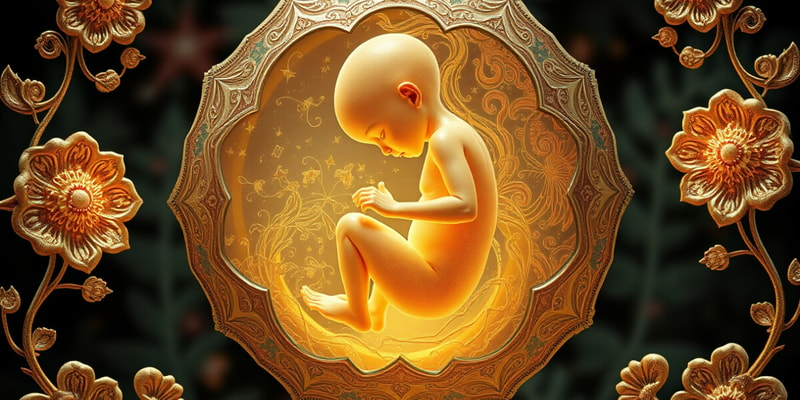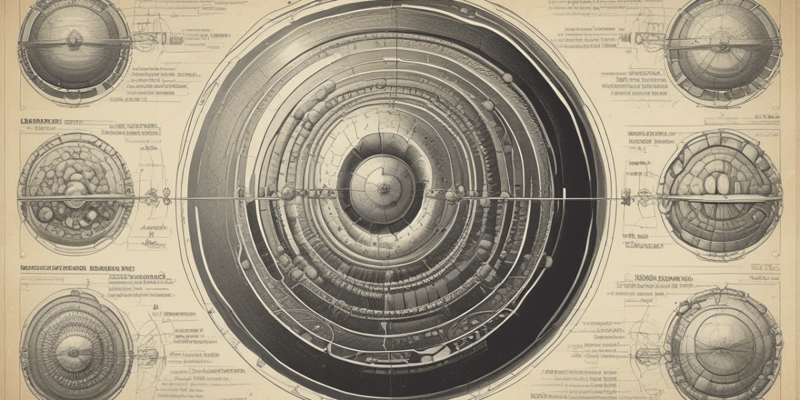Podcast Beta
Questions and Answers
During which phase of cell division does DNA first replicate?
The amount of DNA in a germ cell is doubled during meiosis.
False
What term describes the ball of cells formed after fertilization?
morula
In early embryonic development, the process that initiates differentiation is called __________.
Signup and view all the answers
Match the following stages of prenatal development with their descriptions:
Signup and view all the answers
What is the term used to describe the formation of the trilaminar embryo?
Signup and view all the answers
The sex chromosomes in humans are designated as X and Y.
Signup and view all the answers
What are the two types of chromosomes found in human somatic cells?
Signup and view all the answers
Fertilization leads to the formation of a __________.
Signup and view all the answers
Which stage of human development involves the earliest embryonic development from fertilisation to gastrulation?
Signup and view all the answers
Name one congenital defect associated with abnormal embryological development.
Signup and view all the answers
Match the following terms with their definitions:
Signup and view all the answers
Meiosis is a process that results in the formation of __________ cells.
Signup and view all the answers
What effect does hypermethylation of CpG islands have on gene transcription?
Signup and view all the answers
Histone modification does not affect gene expression.
Signup and view all the answers
What is the main difference between genetics and epigenetics?
Signup and view all the answers
The addition of a methyl group to ______ is a process known as DNA methylation.
Signup and view all the answers
Match the types of epigenetic changes with their descriptions:
Signup and view all the answers
What is the name of the structure formed by the differentiation of the morula?
Signup and view all the answers
The ectoderm layer is formed from cuboidal cells.
Signup and view all the answers
What are the three primary germ layers formed during gastrulation?
Signup and view all the answers
During gastrulation, the _____ streak is formed, facilitating the transition from a bilaminar to a trilaminar disc.
Signup and view all the answers
Which of the following is NOT a fate of the ectoderm?
Signup and view all the answers
Down syndrome is caused by a trisomy affecting chromosome 21.
Signup and view all the answers
What is the function of the notochord formed during gastrulation?
Signup and view all the answers
The _____ layer of the bilaminar disc is responsible for forming the amniotic cavity.
Signup and view all the answers
Match the following cell types with their corresponding derivatives:
Signup and view all the answers
What happens if a gamete with 24 chromosomes fuses with a normal gamete during fertilization?
Signup and view all the answers
Which condition is characterized by an extra X chromosome in boys?
Signup and view all the answers
Turner syndrome occurs when there is an absence of one X chromosome in females.
Signup and view all the answers
What are common clinical features of Down syndrome?
Signup and view all the answers
Monosomy of the X chromosome is a condition associated with ______ syndrome.
Signup and view all the answers
What is a common situation in which autosomal dominant inheritance occurs?
Signup and view all the answers
Genetic defects are only caused by environmental factors.
Signup and view all the answers
Match the following genetic conditions with their inheritance pattern:
Signup and view all the answers
Epigenetics studies how behaviors and environment can cause ______ that affect gene expression.
Signup and view all the answers
Study Notes
Early Embryology and Gastrulation
- Embryonic Development Stages: Covers development from fertilization to gastrulation (weeks 1-3).
- Defects in Development: Discusses known defects like Down’s syndrome and Turner syndrome.
- Epigenetic Influence: Genetic and epigenetic processes play key roles in early embryonic development.
Importance of Studying Embryology
- Head and Neck Development: Understanding embryology is critical for comprehending facial and dental development origins.
- Congenital Defects: Provides insights into causes of congenital defects in related tissues.
- Regenerative Medicine: Relevant for understanding mechanisms in regenerative medicine and dentistry.
Germ Cell Formation and Fertilization
- Somatic Cells: Human somatic cells have 46 chromosomes comprising 44 autosomes and 2 sex chromosomes (X & Y).
- Haploid and Diploid: Gametes are haploid (23 chromosomes); fertilization creates a diploid zygote (46 chromosomes).
- Meiosis vs. Mitosis: Meiosis results in gametes; mitosis results in somatic cell division after DNA replication.
Prenatal Development Stages
- Stage 1 (0-4 weeks): Involves cellular proliferation and migration.
- Stage 2: Morphogenetic processes begin.
- Stage 3: Entails growth and maturation.
Induction, Competence, and Differentiation
- Patterning: Involves initial axial specification and segmentation.
- Induction: Signals cells to differentiate; key agents include homeobox genes and growth factors.
Week 1: From Fertilization to Blastocyst
- Initial Cell Division: The fertilized egg becomes a morula through rapid divisions.
- Blastocyst Formation: Cells reorganize into the blastocyst, consisting of the embryoblast and trophoblast.
Week 2: Implantation of Blastocyst
- Bilaminar Disc: Formation of a two-layered structure (epiblast and hypoblast) occurs around day 8 of gestation.
Week 3: Gastrulation
- Trilaminar Disc Formation: Converts the bilaminar disc into a structure with three primary germ layers: ectoderm, mesoderm, and endoderm.
- Primitive Streak Formation: Initiates extensive cellular rearrangement and migration.
Fate of Germ Layers
- Ectoderm: Forms nervous system, sensory organs, epidermis, and pituitary gland.
- Mesoderm: Develops into notochord, skeleton, muscles, circulatory system, and dermis.
- Endoderm: Forms inner linings of digestive and respiratory tracts, pancreas, and liver.
Defects in Embryonic Development
- Chromosomal Abnormalities: Meiosis malfunction can lead to congenital anomalies affecting head and neck regions.
- Down Syndrome: Result of trisomy 21; characterized by facial clefts and delayed tooth eruption.
- Turner Syndrome (X0): Missing X chromosome leads to short stature and various clinical features.
- Klinefelter Syndrome (XXY): Extra X chromosome results in taller stature and gynecomastia.
Genotype vs. Phenotype
- Genetic Defects: Refer to abnormalities in genetic makeup.
- Genotype: Underlies characteristics affected by environmental context.
- Phenotype: Represents observable traits resulting from development.
Genetics vs. Epigenetics
- Genetics: Examines genes and hereditary information.
- Epigenetics: Involves how behaviors and environment can modify gene expression without changing the DNA sequence.
Mechanisms of Epigenetics
- DNA Methylation: Addition of methyl groups to cytosines affects gene transcription; hypermethylation decreases transcription, while hypomethylation increases it.
- Histone Modification: Changes to histones regulate transcription factor activity.
- Non-coding RNA: Includes siRNA and miRNA, which regulate gene expression and differentiation.
Summary of Differences:
- Genetics vs. Epigenetics: Genetics refers to inherited traits; epigenetics concerns gene activity regulation and environmental influences.
Studying That Suits You
Use AI to generate personalized quizzes and flashcards to suit your learning preferences.
Related Documents
Description
This quiz explores the earliest stages of embryonic development, focusing on the period from fertilization to gastrulation. Key events such as gametogenesis, blastocyst formation, and the formation of the trilaminar embryo will be examined in detail. Prepare to delve into human developmental processes occurring in the first three weeks.




